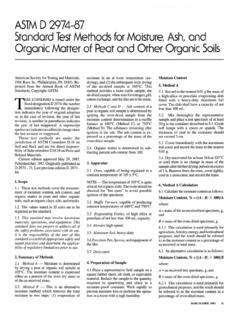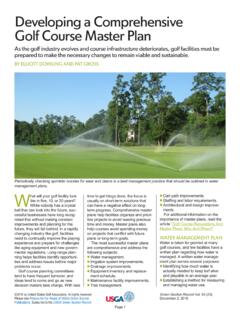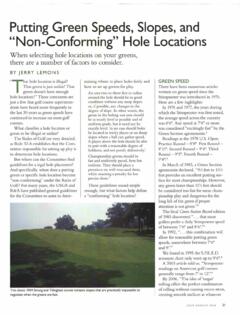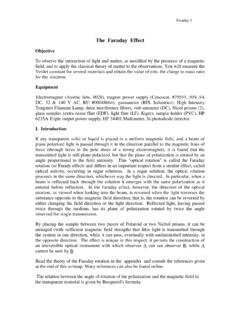Transcription of Understanding The Different Wetting Agent Chemistries
1 Wetting Agent : Any compound that causes a liquid to spread more easily across or pene- trate into the surface of a solid by reducing the surface tension of the liquid. Today s golf course superintendent has a dizzying array of Wetting Agent products available to purchase. As a general class of turf care products, Wetting agents are one of the more frequently used on golf courses. Com- mon sense would suggest that not every surfactant or Wetting Agent is the same. Ironically, all of our turf care fungicides, herbicides, and insecticides are organized into their own classifica-tions, , the DMI fungicides, the strobilurins, the phosphites, etc.
2 Wouldn t it be nice if we could also group Wetting agents and surfactants into the appropriate category of the Different Chemistries from which they are derived? That is the purpose of this article. Over the years, there has been a gradual change in the type of soils used for golf course construction and maintenance. We have evolved from using the old, blended topsoils of years ago (typical manufactured topsoils were 1-1-1 by volume mixes of sand, soil, and peat) to near straight sand soils used today. Sandier soils are used for the construction of greens and tees and even sand capping of fairways.
3 The same sandier soils are used for topdressing of these areas as well. Sands have replaced soils. That s the bottom line. Sandy soils tend to naturally be, or become, hydrophobic (water repelling) in contrast to topsoils, which are less so inclined. One of the most frequently asked questions of USGA Green Section agronomists is, Which is the best Wetting Agent product to use? In a Page 1 Diagnosing localized dry spot and hydrophobic dry patch in the field can be relatively straightforward, especially when noting dew patterns on the grass. Where dew exists, there is good soil moisture. By contrast, only a few inches away, there is no dew on the turf.
4 It is time to test the areas using a soil probe. See next image. The grass is talking to you. Areas without dew are powder dry (on left) whereas samples taken in the adjacent area with dew shows good soil moisture. The powdery dry soil is hydrophobic, or water repelling. No amount of water will rewet the dry area. A Wetting Agent is needed, preferably in combination with some form of surface aeration, to rewet the soil, control turf wilt (and decline), to save labor in hand watering, and to improve turf appearance and The Different Wetting Agent ChemistriesA surfactant is a Wetting Agent but a Wetting Agent may not be a surfactant.
5 Surprised?BY STANLEY J. ZONTEK AND DR. STANLEY J. KOSTK AGreen Section Record Vol. 50 (15)July 20, 2012 TGIF Record Number 208432word, it depends. Specifically, it depends upon what you want that product to accomplish. Is it to rewet a dry, water-repelling soil as the result of isolated dry spot development? Is it to prevent isolated dry spots from developing in the first place? Is it to make, water wetter as an injectable material into your golf course s irri-gation system to try to move water through the soil? Is it to improve irri- gation efficiency and turf performance using less water?
6 Is it to use Wetting agents (rightly or wrongly) as a spray adjuvant when applying herbicides, insecticides, growth regulators, or fungicides? Is it to improve rootzone placement of soil-directed pesticides and fertilizers or to reduce their leach- ing? These are not easy questions to answer because, again, there are so many Different Wetting Agent /soil surfactant Chemistries available to our industry. Note: While a Wetting Agent is a surfactant, it only wets. A surfactant can do more than just wet a dry SURFACTANTS - 101 Soil surfactant products are made with several Different classes of surfactant Chemistries .
7 These classes of chem-istry have molecules with Different structures and therefore they have Different modes of action in how they interact with water and soil. This article will discuss the Different classes of surfactant Chemistries and their vary- ing molecular structures. By defining the capability of each class of surfac-tant chemistry and defining which class or classes of surfactant chemistry each particular soil surfactant product contains, golf course superintendents will better understand the best product to use to address their particular management problem. Note: This article is not intended to recommend one product over another.
8 All Wetting agents/surfactants have specific uses. The goal is to provide information to better understand these products, which allows the end users, golf course superintendents, to decide which product best fits their needs. SURFACTANT CHEMISTRIESIn no special order of Anionic and Blends with Anionics. Anionic Wetting agents are negatively charged surfactants. They can offer fast Wetting but, depending upon application rate, can be phytotoxic to turf. Because of their negative ionic charge, anionics can cause dispersion of clay particles, which can negatively impact soil structure in fine-textured native soils.
9 In the agricultural chemical industry, these compounds are often used to aid in the dispersion of clays in flowable or suspension concentrate formulations. Sometimes referred to as old Chemistries , anionic Wetting agents were introduced into the turf care market in the 1950s. Commercially available anionic blends include: AquaAid, Naiad, Penterra, and Nonionic Polyoxyethylene (POE) Surfactants. A POE (also referred to as alkylphenol ethoxylate, or APE) are also old chemistry Wetting agents. The original AquaGro contained a POE. Like the anionic group of surfac-tants, POEs also can be phytotoxic to fine turf when used in some situations.
10 POEs were originally developed to correct localized dry areas, so they do help treat water repellency, but not nearly as well as newer chemistry Wetting agents that were developed and introduced in the 1990s. This class of chemistry can enhance water movement into the soil. The original products in this category were intro-duced as turf management tools in 1954. Page 2(Left) Note the dew pattern on this Wetting Agent and soil surfactant test area. While a Wetting Agent is a surfactant, it only wets. A surfactant can do more than just rewet the soil. (Right) Dry spots and uneven Wetting can be a problem on any area of the golf course, including greens, tees, roughs, and, in this case, a fairway.




